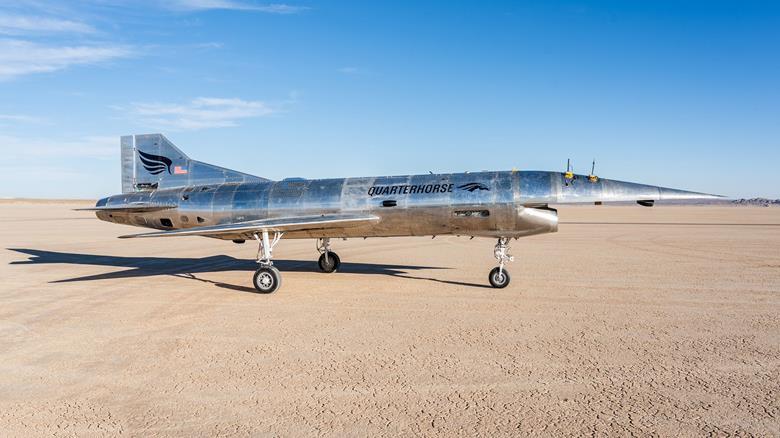The aerospace industry has long pursued the dream of hypersonic flight—aircraft capable of traveling at speeds exceeding Mach 5. Now, Hermeus, an ambitious aviation startup, has taken a significant step toward realizing this vision with the first flight of its Quarterhorse Mk 1 prototype. This milestone marks a crucial phase in the development of reusable hypersonic aircraft, potentially revolutionizing both military and commercial aviation.
A Historic First Flight
On May 27, 2025, Hermeus successfully conducted the maiden flight of the Quarterhorse Mk 1 at Edwards Air Force Base, California. The uncrewed aircraft achieved stable flight and landed smoothly, validating the company’s rapid, iterative approach to aircraft development. This achievement follows extensive ground testing, including high-speed taxi trials, which helped refine the aircraft’s aerodynamic models and control systems.
The Vision Behind Quarterhorse
Hermeus aims to develop a series of progressively advanced aircraft, culminating in a hypersonic vehicle capable of surpassing the legendary SR-71 Blackbird’s speed record of 2,193.2 miles per hour. The Quarterhorse Mk 1, however, is not designed for supersonic flight but serves as a foundational step toward mastering high-speed takeoff and landing—critical capabilities for future hypersonic aircraft.
Engineering Breakthroughs
The Quarterhorse Mk 1 is powered by a General Electric J85 turbojet, the same engine used in the T-38 Talon jet trainer. While this prototype focuses on validating fundamental flight mechanics, future iterations will incorporate more advanced propulsion systems suited for hypersonic speeds. Hermeus has embraced a hardware-rich development approach, building multiple prototypes in quick succession to accelerate progress.
Implications for Aviation
The successful flight of the Quarterhorse Mk 1 signals a paradigm shift in aircraft development. Traditionally, designing and testing new aircraft takes years, if not decades. Hermeus, however, has demonstrated that rapid prototyping and iterative testing can significantly shorten this timeline. The company’s goal of producing one aircraft per year underscores its commitment to pushing the boundaries of aviation technology.
What’s Next?
With the Quarterhorse Mk 1 now airborne, Hermeus is setting its sights on the next phase of development. Future prototypes will explore higher speeds, advanced materials, and innovative propulsion systems. The ultimate objective is to create a fully reusable hypersonic aircraft, capable of drastically reducing travel times and enhancing national security capabilities.
The Quarterhorse program represents a bold step toward the future of aviation. If successful, it could pave the way for commercial hypersonic travel, enabling passengers to traverse continents in mere hours. As Hermeus continues its journey, the world watches with anticipation—hypersonic flight may soon become a reality.
In the ever-evolving world of aerospace innovation, Hermeus is making waves with its ambitious roadmap toward hypersonic flight. The Quarterhorse program, designed to push the boundaries of speed and efficiency, has already demonstrated remarkable progress with the successful flight of the Quarterhorse Mk 1. Now, all eyes are on the Quarterhorse Mk 2, a significant leap forward in the pursuit of supersonic and hypersonic capabilities.
A Legacy of Speed and Innovation
Hermeus' Quarterhorse series is built on the foundation of rapid development and iterative testing. The company’s approach emphasizes hardware-rich prototyping, allowing engineers to refine designs quickly and efficiently. The Mk 1 aircraft, which recently completed its maiden flight at Edwards Air Force Base, was a crucial step in validating high-speed takeoff and landing capabilities.
While Mk 1 was primarily a proof-of-concept, Mk 2 is expected to be a fully operational supersonic test vehicle. Designed to reach speeds exceeding Mach 2.5, this aircraft will incorporate advanced propulsion technology, including a Pratt & Whitney F100 engine equipped with a proprietary precooler system. This innovation allows the turbine engine to handle higher temperatures, paving the way for seamless transitions between subsonic and supersonic flight.
The Technology Behind Quarterhorse Mk 2
One of the most exciting aspects of Mk 2 is its turbine-based combined cycle (TBCC) engine, known as Chimera. This engine merges traditional turbine propulsion with a ramjet, enabling sustained high-speed flight without the need for external boosters or motherships. The precooler technology plays a vital role in this system, cooling incoming air to optimize engine performance at extreme speeds.
The aircraft itself features a delta-wing design, optimized for aerodynamic efficiency and stability at high velocities. Compared to its predecessor, Mk 2 is closer in size to an F-16, making it a formidable testbed for future hypersonic applications.
The Road Ahead: Supersonic and Beyond
Hermeus' vision extends far beyond Mk 2. The company is already laying the groundwork for Darkhorse, a hypersonic reconnaissance and strike platform designed for military applications. These developments signal a new era in aviation, where high-speed flight becomes more accessible and operationally viable.
With Mk 2 expected to take flight in the coming months, the aerospace industry eagerly anticipates the next breakthrough in supersonic and hypersonic technology. If successful, Hermeus will not only redefine the limits of speed but also revolutionize air travel and defense capabilities.
Hermeus' Darkhorse is an advanced hypersonic uncrewed aerial system (UAS) designed for defense and national security missions. It represents a major leap in aerospace technology, offering unprecedented speed, altitude, and maneuverability.
Key Features of Darkhorse:
Hypersonic Speeds: Expected to reach Mach 5, transitioning from turbine propulsion to ramjet power.
Chimera II Engine: Uses a Pratt & Whitney F100-229 turbofan, modified for high-speed flight.
Multi-Mission Capability: Designed for intelligence, strike, and reconnaissance operations.
Defense Applications: Aims to provide a low-cost, reusable hypersonic platform for the U.S. military.
Future Civil Transport: Lays the groundwork for Halcyon, a piloted high-speed transport concept.
Darkhorse builds on the Quarterhorse program, leveraging lessons from Mk 1, Mk 2 to push the boundaries of hypersonic flight. It’s an exciting step toward making high-speed aviation more accessible and operationally viable.






